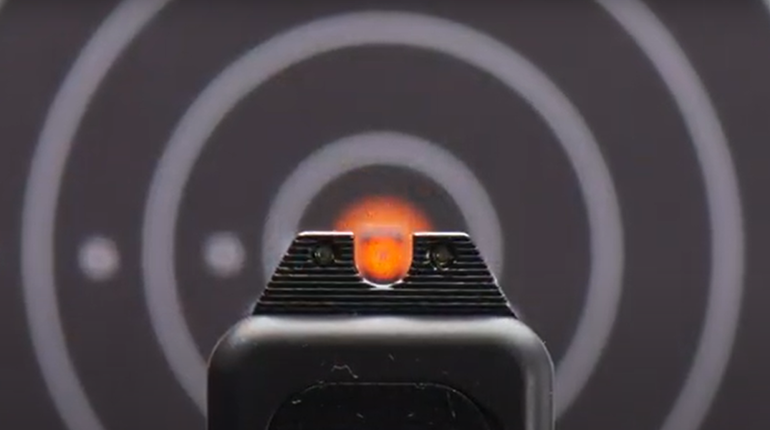
Above: Notched buckhorn sight, on a Chiappa LA322 lever-action rifle.
In Part 1 of our series on iron sights, we discussed aperture and post-and-notch sights. This installment will cover buckhorn sights, express sights, fiber-optic sights and the two main types of shotgun sights.
Buckhorn Sights
Buckhorn rear sights are used on many factory hunting rifles as they are simple, rugged and easy to use, though not capable of the same precision as a target-style peep sight. The rear sight blade has a nearly closed V-shaped notch, often with a small circular or U-shaped cutout at the bottom. Sight alignment consists of placing the front post bead squarely in the bottom of the cutout in the notch. Windage adjustment is accomplished by drifting the front or rear sight units laterally in their dovetails. On many buckhorn sights, the rear sight blade rides on a stepped elevator that allows coarse elevation changes.
Express Sights
Express sights are similar to buckhorn sights in that they have a front bead on a post and rear blades with shallow U-shaped notches. Instead of a stepped elevator for rear sight elevation changes, express sights employ one or more flip-up blades of different heights marked for different ranges. This system allows quick, one-handed elevation adjustment. When several sight blades are used, this type of sight is sometimes also called a "multiple leaf sight." Express sights are most often used on large-caliber rifles intended for hunting dangerous game.
The major drawback of express sights is that they must be factory-regulated for a specific load and bullet weight. This restricts the rifle to a specific loading and is time-consuming and expensive.
Fiber-Optic Sights
Fiber-optic materials, usually in the shape of a small plastic rod or cylinder, are able to take in light from a variety of angles and redirect it along their axis. Seen end-on, fiber-optic units appear to be glowing dots.
Increasingly, fiber-optic units are being incorporated into front and rear sights for handguns, shotguns and rifles. When used in sunlit conditions, fiber-optic sights offer enhanced visibility and contrast. This feature is greatly appreciated by shooters with poor eyesight or visual impairments. At dusk, dawn or under poor light conditions, fiber-optic sights are considerably easier to see than conventional iron sights.
Fiber-optic sights may have either a single front sight unit paired with a conventional rear sight or front and rear sight units presenting the fiber optics in a three-dot pattern. Fiber-optic rods come in a variety of colors, including green, red, orange and yellow.
Shotgun Sights
Either of two types of sights may be found on shotguns:
Bead Sights
Shotguns designed for wingshooting or for clay target competition are pointed rather than aimed. Such shotguns have a front bead, and sometimes an additional mid-rib bead, that serve as visual reference points when firing at rapidly moving targets. The bead(s) are mounted in the barrel's sighting plane or on a ventilated rib. Such ribs are mounted on the barrel where they serve as a sighting plane to guide the shooter's eye toward the target. Most ribs have a series of crosswise grooves or cross-hatching machined into the upper surface to reduce light reflection.
Front beads are typically made of brass, white plastic or metal—often with a high-visibility orange or red insert. Mid-rib beads are almost always brass and of substantially smaller diameter than front beads.
Iron Sights or Optical Sights
Shotguns used for hunting game such as deer, bear and turkey often have rifle-type iron sights or optical sighs, as these shotguns are aimed rather than pointed. Similar sights may be used on shotguns intended for defensive, police or military use. Ghost-ring sights are another popular choice for these shotguns.







































